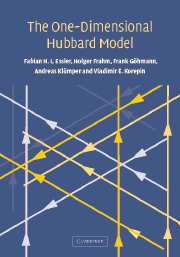Book contents
- Frontmatter
- Contents
- Preface
- 1 Introduction
- 2 The Hubbard Hamiltonian and its symmetries
- 3 The Bethe ansatz solution
- 4 String hypothesis
- 5 Thermodynamics in the Yang-Yang approach
- 6 Ground state properties in the thermodynamic limit
- 7 Excited states at zero temperature
- 8 Finite size corrections at zero temperature
- 9 Asymptotics of correlation functions
- 10 Scaling and continuum limits at half-filling
- 11 Universal correlations at low density
- 12 The algebraic approach to the Hubbard model
- 13 The path integral approach to thermodynamics
- 14 The Yangian symmetry of the Hubbard model
- 15 S-matrix and Yangian symmetry in the infinite interval limit
- 16 Hubbard model in the attractive case
- 17 Mathematical appendices
- References
- Index
13 - The path integral approach to thermodynamics
Published online by Cambridge University Press: 19 August 2009
- Frontmatter
- Contents
- Preface
- 1 Introduction
- 2 The Hubbard Hamiltonian and its symmetries
- 3 The Bethe ansatz solution
- 4 String hypothesis
- 5 Thermodynamics in the Yang-Yang approach
- 6 Ground state properties in the thermodynamic limit
- 7 Excited states at zero temperature
- 8 Finite size corrections at zero temperature
- 9 Asymptotics of correlation functions
- 10 Scaling and continuum limits at half-filling
- 11 Universal correlations at low density
- 12 The algebraic approach to the Hubbard model
- 13 The path integral approach to thermodynamics
- 14 The Yangian symmetry of the Hubbard model
- 15 S-matrix and Yangian symmetry in the infinite interval limit
- 16 Hubbard model in the attractive case
- 17 Mathematical appendices
- References
- Index
Summary
A very curious situation arises in the context of the calculation of the partition function from the spectrum of an integrable Hamiltonian. Despite the validity of the Bethe ansatz equations for all energy eigenvalues of the model the direct evaluation of the partition function is rather difficult. In contrast to ideal quantum gases the eigenstates are not explicitly known: the Bethe ansatz equations provide just implicit descriptions that pose problems of their own kind. Yet, knowing the behaviour of quantum chains at finite temperatures is important for many reasons. As a matter of fact, the groundstate is strictly inaccessible due to the very fundamentals of thermodynamics. Therefore the study of finite temperatures is relevant for theoretical as well as experimental reasons. At high temperatures, quantum systems show only trivial static properties without correlations. Lowering the temperature, the systems enter a large regime with non-universal correlations and finally approach the quantum critical point at exactly zero temperature showing universal, non-trivial properties with divergent correlation lengths governed by conformal field theory [51].
In Chapter 5 of this book we have discussed the traditional Thermodynamical Bethe Ansatz (TBA) as developed for the Heisenberg model and the Hubbard model [155, 433–435] on the basis of a method [496] invented for the Bose gas.
- Type
- Chapter
- Information
- The One-Dimensional Hubbard Model , pp. 488 - 562Publisher: Cambridge University PressPrint publication year: 2005



